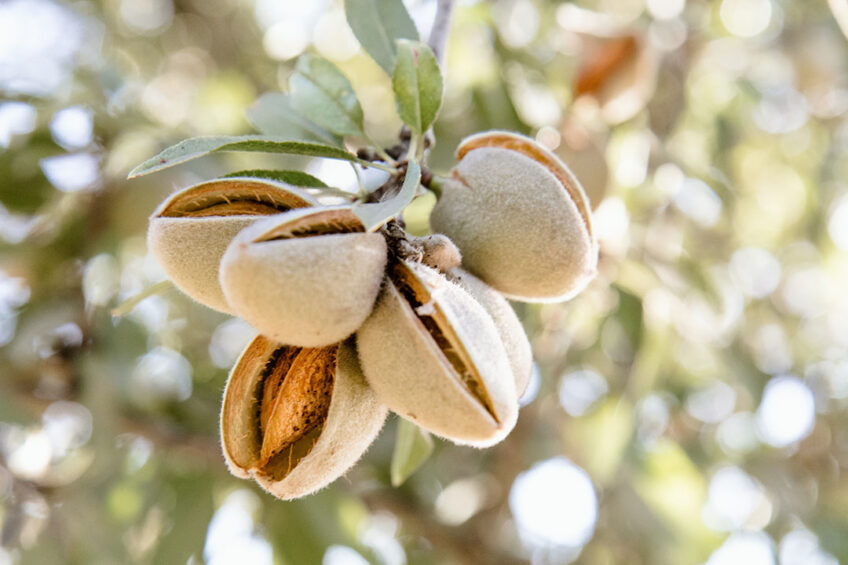Almond hull feed trial to reduce methane emissions in dairy cows

Olam Food Ingredients will soon start a trial that will see almond hulls and shells repurposed into a nutritious feed source for dairy cows in New Zealand. Using this by-product of almond processing has the potential to help reduce both methane emissions and input costs on farms.
Olam Food Ingredients (OFI) operates large-scale almond orchards in Australia. The trial will see the almond hulls and shells from these orchards used as a food source. According to Paul Johnson, general manager of milk supply for OFI New Zealand, almond hulls are a proven source of nutrition for dairy cows.
“As part of our research for the trial, we met with Australian dairy farmers successfully using almond hulls as a source of fibre in a pasture-based system. That gives us confidence that the model will work well here in New Zealand,” he says.
The feed will be supplemented with Agolin Ruminant, which has the potential benefit of reducing methane emissions and increasing the feed conversion rate, which in turn will support milk yields. Johnson says the trial period will explore ways to efficiently and effectively package and transport the feed, and assess if the feed can be manufactured and used in New Zealand at scale.
Making a difference to farmers’ bottom lines
Another part of the assessments will determine how to blend the hulls and shells in an optimum way with existing feed used in New Zealand dairy farming blends or supplied in bulk on farm. “We know animal feed is a significant input cost on a dairy farm and believe this trial will make a real difference to our farmers’ bottom lines,” Johnson emphasises.
OFI country head for Australia and New Zealand, Duncan Smith, says the trial will also bring benefits to OFI’s Australian operation. “Finding a consistent way to repurpose almond hulls and shells, which are a nutritious by-product of our almond processing, has been a priority for us as it will contribute to a more efficient and sustainable way of operating on our orchards.”
Research in California has shown that almond hulls are a dairy feedstuff with an overall nutritional value equal to mid-grade alfalfa hay. It can be included in diets of dairy cows at levels as high as 20% of diet dry matter with little or no negative impact on animal performance.
According to a survey of the University of California Cooperative Extension specialists, the most common by-product feed on dairy farms in California are almond hulls. California supplies roughly 80% of the world’s almonds. That is also where many dairies are.
High levels of milk production
Researchers at the University of California have demonstrated that almond hulls fed to lactating dairy cows at varying amounts (up to 20% of the diet) can support high levels of milk production. Almond hulls are high in sugars and neutral detergent fibre (NDF) but low in protein content. Much of the NDF in the hulls can be degraded by ruminant microbes, as it contains low lignin content.
In addition to NDF, almond hulls supply cows with an excellent source of highly fermentable carbohydrates in the form of sucrose, fructose, glucose, inositol, and sorbitol. This high content of fermentable carbohydrates could make almond hulls a good and relatively cheap substitute for concentrate ingredients such as corn. And almond hulls can easily be dried during the harvesting process, making them an easy feed to store for dairies.
Olam Australia owns 12,000 hectares of orchards across 11 farms in the Sunraysia district in Australia. Olam also has an almond hulling and processing plant, the largest facility of its kind in the southern hemisphere, in Carwarp, Victoria. This 12,000 sqm facility can de-hull and shell 14 tonnes of almonds per hour.
OFI ranks among the top 3 dairy suppliers in the world. The Singapore-based conglomerate is well known to New Zealand’s dairy industry. The company is currently building a dairy plant in Tokoroa on the own in the North Island of New Zealand. The plant will become part a global network that spans 20 major milk consumption markets, such as South-East Asia, China, the Middle East, and Africa.
Join 13,000+ subscribers
Subscribe to our newsletter to stay updated about all the need-to-know content in the dairy sector, two times a week.










